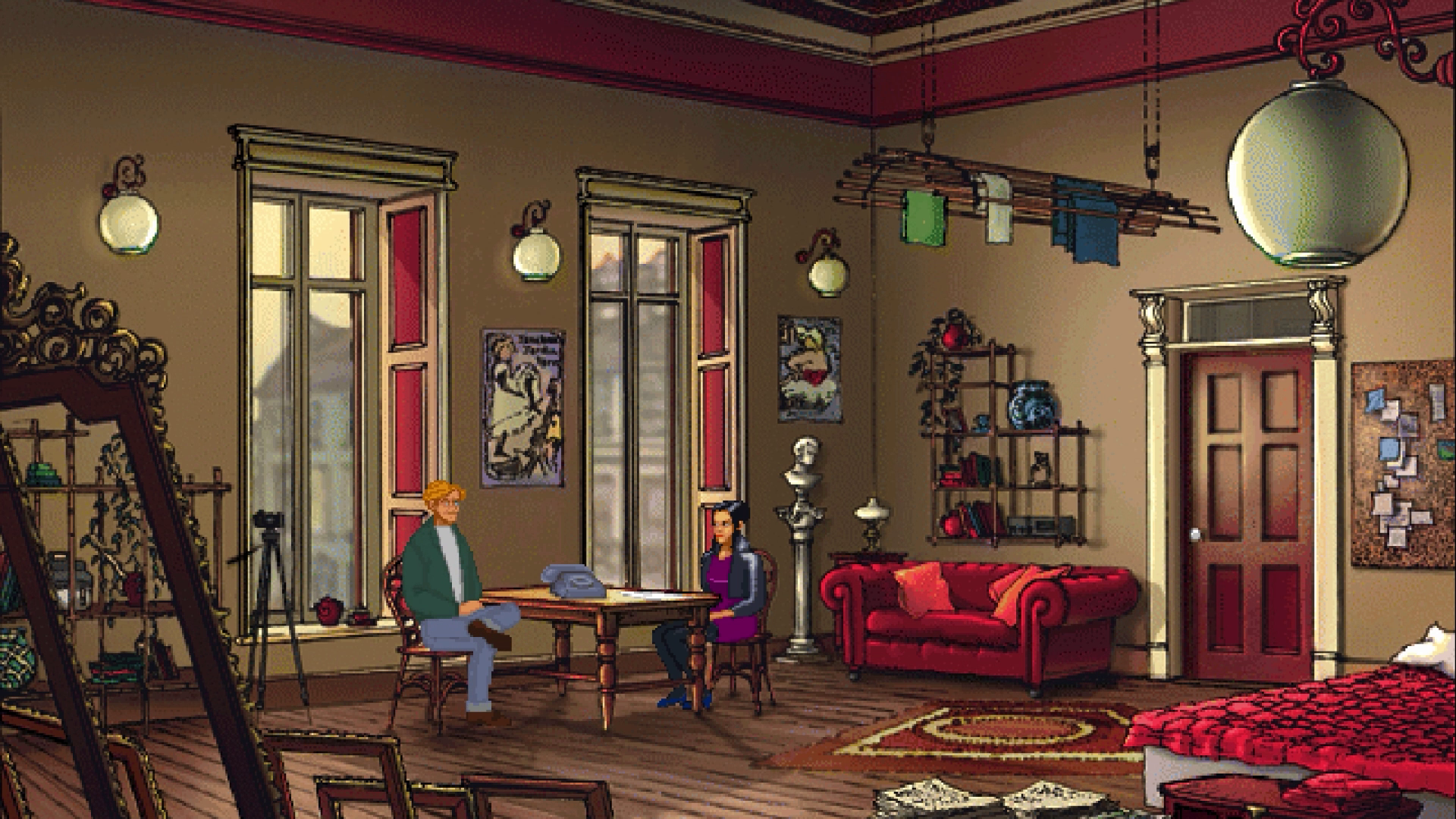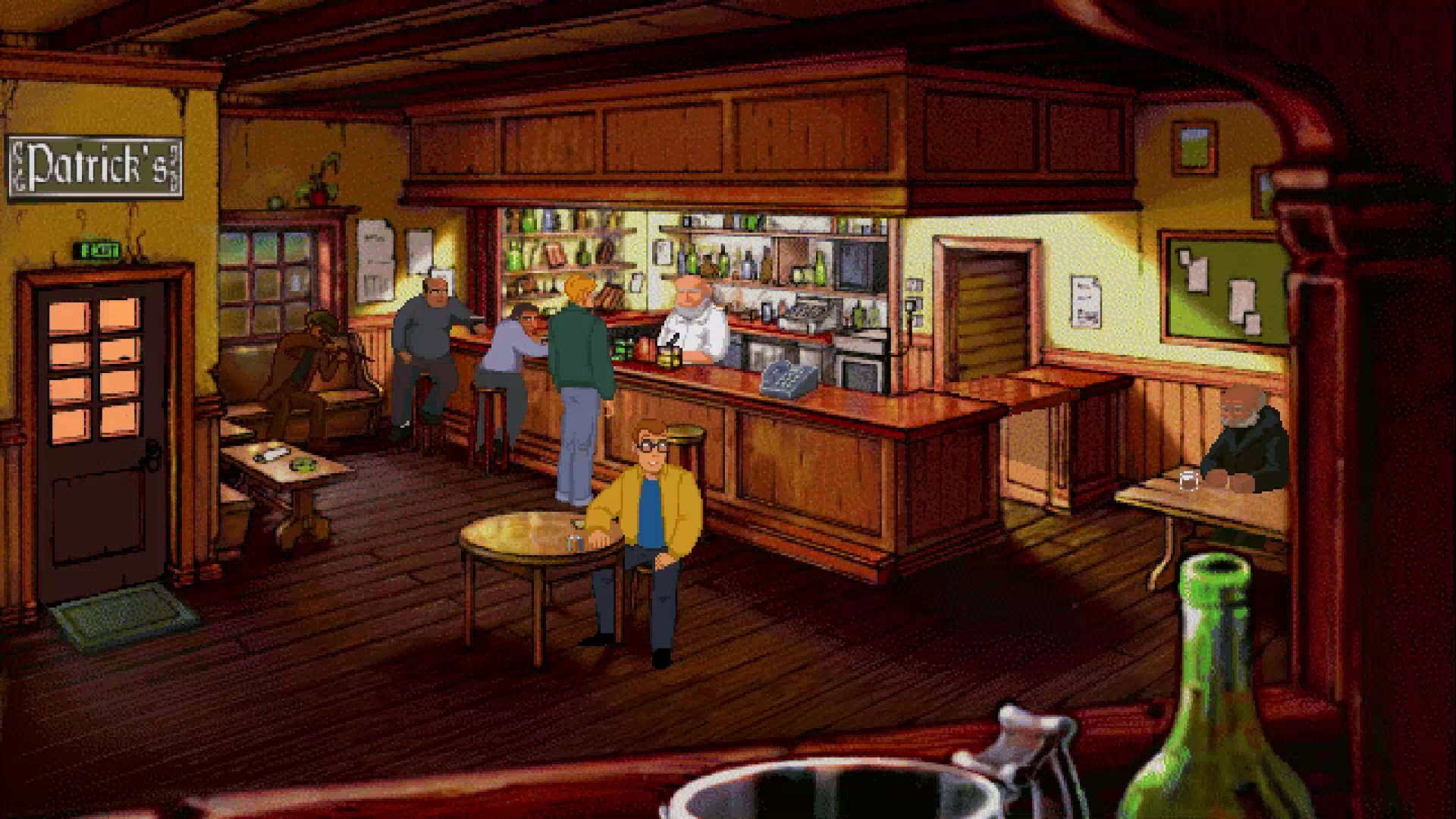Broken Sword is still point-and-click perfection
Revisiting a '90s adventure classic.

Broken Sword knows every great mystery needs a killer premise to hook you in. It begins with an American tourist on vacation in France, sipping coffee outside a Parisian cafe. Then a guy dressed as a clown blows it up. Most people would fly home and try to forget about it, but George Stobbart is not most people: he's an adventure game protagonist. You know what those guys are like. Vacation be damned, he wants to know who tried to kill him—and he's going to do it by picking up random objects and solving puzzles with them.
Developed by UK studio Revolution Software and released in 1996, Broken Sword is one of the best point-and-click adventure games ever made. It's beautiful to look at. The puzzles are great. The music is sublime. The characters are memorable. The story is full of twists and turns. And it's funny. Like, really funny. It's everything an adventure game should be, and age hasn't dulled its edge one bit. Four more games were released after this one, and while they all have their moments, the original is the best.
George is not a detective; he's a lawyer with a goofy sense of humour. But nearly being blown up by a terrorist disguised as a clown inspires him to become one, and reveals a deeper side to him. He's smart, resourceful, and absolutely unshakeable when it comes to the pursuit of justice. He searches the streets (and, more than once, the stinking sewers) of Paris for clues. And as you play, his pockets begin to overflow with objects that may or may not be related to the case. It is an old school adventure game after all.
A plastic red nose. A torn piece of oddly patterned fabric. An ancient medieval manuscript. A small handful of plaster of Paris. A greasy tissue. Man, George really loves showing people that gross, slimy tissue. Waving it in front of anyone who'll listen, saying "What does this tissue mean to you?", and awaiting the inevitable disgusted response is one of the game's best running jokes. Every time I meet a new character, it's the first thing I do, just to see their horrified reaction. And the game knows it, throwing in the odd unexpected response, or a line that takes a subtle dig at you for behaving like such an oddball.
Man, George really loves showing people that gross, slimy tissue.
As he investigates the bombing, George finds a partner: a newspaper reporter called Nico Collard, whose apartment George visits regularly throughout the game. They have real chemistry, and I love how their relationship grows over the course of the game. It's one of the best depictions of a friendship forming I've seen in a game. Together the pair find themselves tangled up in an ancient conspiracy that runs far deeper than they ever imagined. The killer clown was just the tip of the iceberg, and one small part of a larger, more complex mystery.
One of the best things about Broken Sword's story is how it's all based on real history—specifically the legend of the Knights Templar. As George hunts for the clown, he learns about this ancient order of knights and a treasure hoard they supposedly hid before they were dissolved and their last Grand Master was burned at the stake in Paris. Author Dan Brown famously leaned on the same mythology in his wildly popular book The Da Vinci Code, which has a lot in common with Broken Sword—but Revolution did it first.

In Broken Sword, the Templars still exist and are trying to take over the world—a plan George and Nico take it upon themselves to stop. It's a compelling mix of real-world history and the occult, wrapped around an intriguing murder mystery. George's quest for the truth takes him all over the world, from Paris to a sleepy town in Ireland, a Syrian marketplace, a Spanish villa, and a train speeding through the Scottish countryside. It's a real globe-trotting adventure, and the colourful, evocative scenery is constantly changing around you.
Keep up to date with the most important stories and the best deals, as picked by the PC Gamer team.
Ireland is probably the highlight. George is here following a lead about an archeological dig where a priceless Templar artifact has allegedly been dug up. When he gets there, his first stop is MacDevitt's—a rustic country pub specialising in real ale and frequented by talkative locals. If I could drink a pint in any virtual pub, it would be this one.I like to think I'd be able to handle the booze better than George, though. Order one too many and he starts getting rowdy. Well, as rowdy as a Californian lawyer can get. And the barman doesn't seem too keen on his drunken idea to turn MacDevitt's into a trendy cocktail bar.
The overarching story in Broken Sword is great, but it's moments like this that make it really special. The quiet moments where the well-written characters are given a chance to shine, and the warm, witty humour comes to the forefront. It's an incredibly cosy game. The slow pace, painterly hand-drawn backgrounds, and orchestral music give it a really pleasant atmosphere. If you've ever watched a British detective drama, it has a similar vibe. Thrilling, exciting, but in a subtle way, with lots of nice scene-setting and quirky, light-hearted conversations inbetween all the gruesome murders and other grim stuff.

George meets a lot of memorable characters, including a hospital cleaner whose best friend is a floor polishing machine called Mr. Shiny, a detective convinced he has psychic powers, and mischievous youngster Liam Maguire, who tries to rope him into a scheme to steal him a crate of lager. And who can forget Lady Pierremont, an obscenely posh hotel guest with a plummy English accent who helps George pilfer the key to a room through sheer upper class arrogance. I love these weirdos. Their voices are forever etched into my mind.
The voice acting, incidentally, is brilliant. It's quite scrappy in places, occasionally sounding like it was recorded in a bathroom stall. (It might have been; Revolution was a small studio at the time.) But that only adds to its charm. And actor Rolf Saxon (who has appeared in a bunch of stuff, including Tomorrow Never Dies, Saving Private Ryan, and Mission: Impossible) is perfect as George Stobbart. In fact, I don't know if the character would work half as well without him. He brings just the right amount of warmth and deadpan humour to the role, but with a tough, determined edge, just like the character himself.
It's one of the prettiest and most atmospheric adventure games of the period.
Broken Sword's animation is also unbelievably lavish and expressive, which is another important part of why its characters are so memorable. The way they move says as much about them as their voices, whether it's Lady Pierremont's indignant march towards the reception desk at the hotel, or Sean Fitzgerald twitching and eyeing the door nervously in MacDevitt's, visibly worried about something. Artistically, it's one of the prettiest and most atmospheric adventure games of the period. And even though it looks quite low-res and pixelated on big, modern monitors, the quality of the art direction shines through.
But as laid back as Broken Sword is, you can still die. Mistakes that lead to George's untimely demise are usually clearly signposted, but you won't be able to resist putting him into dangerous situations to see what happens. You can always reload. Honestly, these scenes feel kind at odds with the rest of the game. It's quite jarring to go from this fun, silly, rip-roaring adventure, to lovely, goofy George being given a pair of concrete shoes by some shady gangsters and thrown into the Seine. It does at least add a sprinkle of danger.

Of course, you can't talk about Broken Sword without mentioning the goat puzzle. It stumped so many people at the time that it even has its own Wikipedia page. It's actually pretty simple. When the goat knocks you down, quickly click the old plough on the other side of the screen to trap it. The problem is, there are no other timing-based puzzles in the game. None up until that point, and none after. So you can understand why it has most players reaching for a walkthrough. However, if you're playing the later Director's Cut version of Broken Sword, the timing element has been removed entirely, making the goat puzzle not so infamous, and actually quite easy.
But which version should you play? The Director's Cut is excellent, adding a whole new prologue chapter where you play as Nico, new puzzles, neat character portraits by Dave 'Watchmen' Gibbons, a nicely designed hint system, and more. But some elements I'm not so keen on, like the comic book-style text bubbles. I personally prefer playing the original version on ScummVM, because it's the one I remember playing when I first discovered the game. But either way, you're gonna have a good time, and the Director's Cut is like $5.
It's a shame that dumb goat puzzle is what most people think of when they hear the name Broken Sword, because it's really the least interesting thing about the game. This is a smart, funny, and deeply charming adventure game, and still wonderfully playable today. The puzzle design is mostly logical, fair, and even-handed, rarely slipping into the brain-twisting, item-mashing absurdism of many other point-and-click adventures from the mid-to-late '90s. I'm looking at you, LucasArts. Wacky puzzles, while a staple of the adventure genre, don't age well, which I think is part of Broken Sword's enduring appeal. It's a game I play at least once a year, and every time I do, the magic is still there.
If it’s set in space, Andy will probably write about it. He loves sci-fi, adventure games, taking screenshots, Twin Peaks, weird sims, Alien: Isolation, and anything with a good story.


